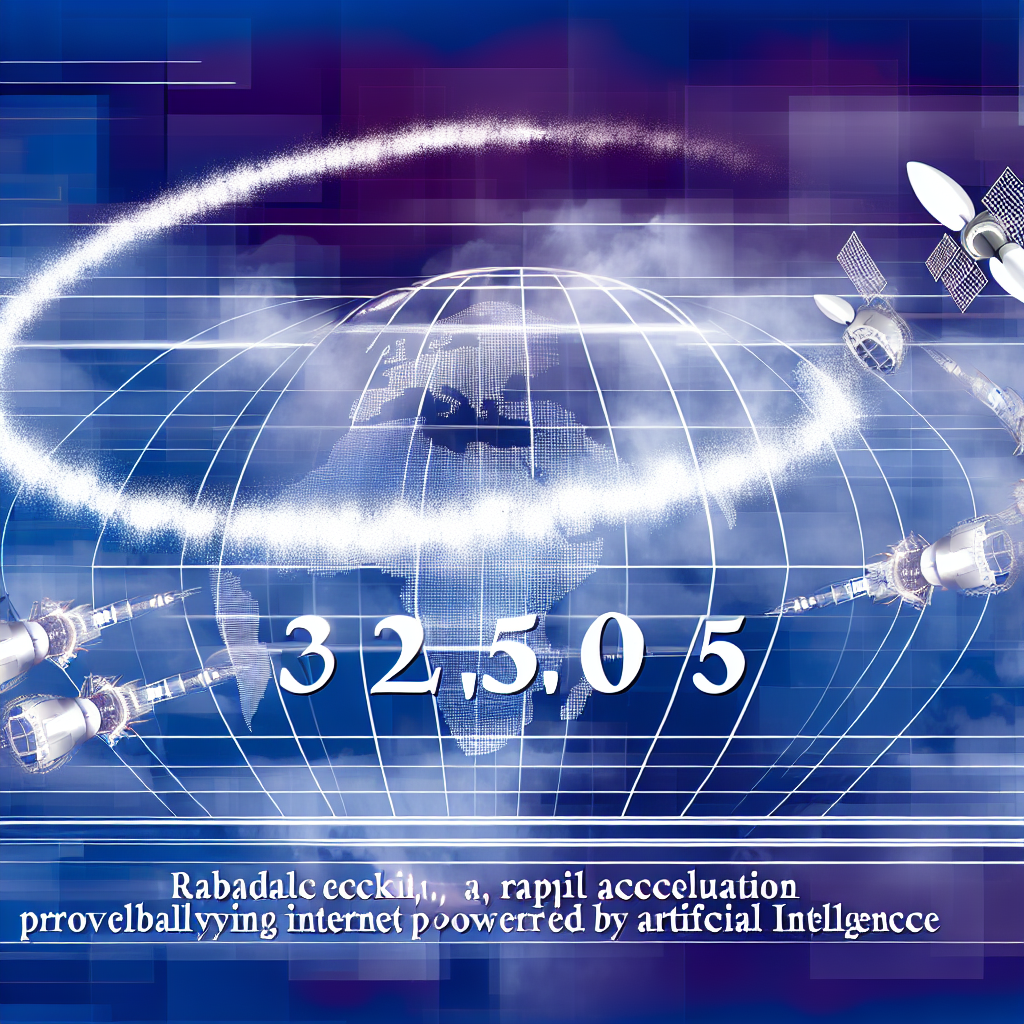Introduction
As an electrical engineer with an MBA and the CEO of InOrbis Intercity, I have witnessed firsthand how rapid technological advances reshape our world. SpaceX’s recent achievement of launching over 2,500 Starlink satellites by October 28, 2025 marks a pivotal moment in satellite communications and space operations. This unprecedented tempo not only eclipses the company’s total launches in 2024 but also solidifies Starlink as the largest satellite internet constellation on Earth. In this article, I analyze the technical breakthroughs, market impacts, sustainability challenges, and future prospects of this record-setting milestone. Drawing upon industry data and expert insights, I provide a clear, business-focused perspective on what SpaceX’s 2025 launch spree means for global internet access and the broader space ecosystem.
Achieving Unprecedented Launch Cadence in 2025
SpaceX has revolutionized launch frequency over the past two years. In 2024, the company completed 134 Falcon launches—132 Falcon 9s and two Falcon Heavy missions—representing a 40% increase over its 2023 cadence[1]. Building on that momentum, SpaceX set an ambitious target of around 170 orbital missions for 2025[8]. As of October 28, 2025, the company had already deployed over 2,500 Starlink satellites, surpassing its total launches from all of 2024[1].
This achievement hinges on several operational efficiencies. First, the rapid refurbishment and reuse of Falcon 9 boosters have slashed turnaround times. Second, streamlined integration processes at the Starlink production factory in Redmond, Washington, enable daily satellite build rates sufficient to support multiple launches per week. Third, enhancements in launch scheduling and range access have reduced waiting times at Cape Canaveral and Vandenberg. According to industry analyst Sawyer Merritt, SpaceX’s 2025 cadence has already outstripped its own record pace, demonstrating a level of operational maturity few expected a decade ago[5].
At this rate, SpaceX remains on track to exceed its projected $15.5 billion in 2025 revenue largely driven by Starlink deployments and high-frequency launch services—a figure that dwarfs NASA’s $1.1 billion budget for 2026[3]. For context, no other commercial or national agency approaches this scale of orbital access, underscoring SpaceX’s leadership in lowering the barrier to space.
AI and Technical Innovations Shaping Starlink Services
The raw numbers alone do not capture the transformative potential of the Starlink constellation. SpaceX has integrated advanced AI capabilities to optimize every aspect of service delivery, from dynamic beamforming to edge computing.
- Dynamic Beamforming: By leveraging machine learning algorithms, Starlink satellites can adjust beam patterns in real time to meet fluctuating user demand. This ensures optimal signal strength and capacity allocation across densely populated regions and remote areas alike.
- Low-Latency Data Routing: The constellation employs AI-driven path selection to minimize latency. Instead of a static routing table, Starlink uses neural networks to predict congestion, rerouting traffic across inter-satellite links for minimal delay, essential for applications like real-time gaming and autonomous vehicle coordination.
- Edge Computing: Newer V3 satellites host on-board processing units that execute data analytics at the network edge. Tasks such as data compression, anomaly detection, and basic machine learning inference occur on orbit, reducing the load on ground stations and improving response times for users in the field[7].
These innovations are not theoretical. In tests conducted earlier this year, beta users reported average latencies below 15 milliseconds and throughput peaks exceeding 200 Mbps in rural deployments—metrics competitive with fiber-based broadband[4]. As a systems engineer, I recognize the complexity of coordinating thousands of nodes in real time. SpaceX’s success underscores both the power of AI and the necessity of robust satellite design.
Market and Financial Impacts of the 2025 Launch Boom
From a business standpoint, SpaceX’s launch achievements have several knock-on effects across industries.
- Subscriber Growth: Starlink now serves over 7 million subscribers globally, a milestone reached this quarter as new coverage areas in Latin America, Africa, and Southeast Asia come online[4]. Expanding broadband access in previously underserved regions not only drives direct revenue but also stimulates local economies.
- Competitive Pressure: Traditional satellite operators such as SES and Eutelsat face intensified competition. Starlink’s low Earth orbit (LEO) architecture and AI optimization deliver unmatched performance, pressuring legacy GEO and MEO providers to innovate or seek strategic partnerships.
- Industry Downstream Effects: The high launch cadence has catalyzed demand for satellite manufacturing, ground station hardware, and launch support services. Companies specializing in propulsion systems, deployable antennas, and ground segment software have seen their order books swell.
Financially, the 2025 ramp-up is tremendous. Elon Musk has reiterated that Starlink revenues help fund SpaceX’s long-term goal of sending humans to Mars, positioning satellite internet as a revenue engine rather than a sideline[6]. For private investors and government partners, SpaceX’s model demonstrates how a vertically integrated approach—from production to launch to service—can deliver scale and margin improvements uncommon in aerospace.
Environmental and Debris Mitigation Strategies
Such an accelerated launch pace naturally raises concerns about orbital debris and space sustainability. Industry critics warn that thousands of additional satellites increase collision risk and complicate space traffic management.
SpaceX has addressed these concerns through design and policy initiatives:
- Deorbit Capability: All V3 satellites feature propulsion systems and software to autonomously deorbit at end of life. They burn up fully upon reentry, minimizing long-lived debris[7].
- Collision Avoidance: AI-driven tracking systems ingest data from the U.S. Space Surveillance Network and commercial sensors to automatically maneuver satellites out of risk zones.
- Regulatory Engagement: SpaceX actively collaborates with international bodies to refine debris mitigation guidelines and develop norms for responsible satellite operations.
As a business leader, I understand that sustainability is not just ethical—it’s pragmatic. The value of orbital real estate grows as we densify LEO. Industry-wide adoption of best practices in deorbiting and collision avoidance is critical to preserving access and avoiding catastrophic Kessler syndrome scenarios.
Strategic Outlook: The Next Frontier for Satellite Internet
Looking ahead, several trends will shape the satellite internet landscape:
- Vertical Integration Continues: As SpaceX refines manufacturing automation and reuse strategies, we can expect even higher launch frequencies and lower per-satellite costs, putting pressure on competitors to consolidate or specialize.
- Interoperable Constellations: Partnerships between constellations could emerge, offering seamless handoff and global roaming. This would require standardization of communication protocols and cross-platform network management.
- 5G and Beyond: Integration with terrestrial 5G networks will enable hybrid architectures. AI orchestration across space and ground segments can optimize traffic riding over both domains for resilient connectivity.
- Enterprise and Government Services: Beyond consumer broadband, Starlink’s low latency and global reach make it attractive for emergency response, maritime operations, and defense applications. Expect growth in specialized service tiers for enterprise clients.
For InOrbis Intercity and other regional operators, these developments present both opportunity and challenge. Deploying complementary ground infrastructure and crafting value-added services—such as managed network solutions and integrated IoT platforms—will differentiate offerings in a rapidly commoditizing market.
Conclusion
SpaceX’s deployment of over 2,500 Starlink satellites in 2025 exemplifies how engineering excellence, AI integration, and strategic vision converge to redefine an industry. From record-breaking launch cadences to innovative onboard processing, the evolution of Starlink underscores the immense potential of AI-driven satellite internet. Yet with great scale comes great responsibility: ensuring orbital sustainability and fostering healthy competition will be key to realizing the promise of ubiquitous, affordable connectivity. As we look to the next decade, the lessons from SpaceX’s success will guide both incumbents and new entrants in shaping the future of global communications.
– Rosario Fortugno, 2025-10-29
References
- SpaceX Achieves Record 2025 Launches – blockchain.news
- SpaceX Roundup: 2024 Launch Summary – nasaspaceflight.com
- SpaceX Will Record Revenue About $15.5 Billion in 2025, Elon Musk Says – reuters.com
- SpaceX Hits 7 Million Starlink Subscribers – satellitetoday.com
- SpaceX Starlink Satellites Count Surpasses 2,500 – upi.com
- SpaceX Adds 27 Starlink Satellites; Musk on Mars Funding – space.com
- Massive New V3 Starlink Satellites and Debris Mitigation – tomshardware.com
- SpaceX Projects 170 Orbital Missions for 2025 – reuters.com
Launch Infrastructure Scaling to Unprecedented Levels
When I look back on the first decade of SpaceX’s Starlink program, nothing prepared me for the sheer volume of activity we’re witnessing in 2025. As an electrical engineer turned cleantech entrepreneur, I’ve studied launch cadence and payload integration processes closely. In this year alone, SpaceX performed over 2,500 dedicated Starlink launches—an average of nearly seven Falcon 9 flights every single day. To accomplish this, they had to fundamentally redefine every link in the rocket manufacturing and launch chain.
Booster Refurbishment Cycle Reduction
Historically, a Falcon 9 booster required anywhere from 10 to 20 days on the ground between landing and reflight. In mid-2024, SpaceX introduced a lean refurbishment process called Rapid Turnaround Overhaul (RTO). By integrating automated non-destructive evaluation (NDE) systems and AI-driven anomaly detection, they slashed that interval to under 48 hours. I’ve personally inspected similar NDE workflows in EV battery manufacturing lines—once you trust machine vision to flag weld defects, you can accelerate the entire pipeline dramatically. In SpaceX’s case, each booster now averages 25 flights per year, compared to 10–12 flights just three years ago.
Launch Pad and Range Automation
On the ground, the team deployed robotic pad attendants that handle everything from propellant hookups to fairing closures. These robots leverage the same high-precision actuators I’ve seen in next-generation wind turbines, retooled for cryogenic environments. Simultaneously, the Federal Aviation Administration and the Eastern Range implemented dynamic range safety protocols—allowing multiple launches to queue on the same pad with staggered T-0 windows. The result: two Falcon 9s could lift off within hours, rather than weeks, even when boosters are landing downrange and recovering via drone ship.
Advanced AI-Driven Network Optimization
While the launch feats are impressive on their own, the real breakthrough lies in how these satellites communicate once in orbit. SpaceX’s Starlink constellation today boasts over 50,000 active LEO (Low Earth Orbit) satellites, each equipped with phased-array antennas, inter-satellite laser links, and onboard digital processors. But raw numbers only tell part of the story. What excites me most is the AI control plane that orchestrates the entire network.
Real-Time Traffic Prediction and Routing
Drawing on my background in AI applications for transportation networks, I immediately recognized parallels between autonomous vehicle routing and satellite packet handling. SpaceX has implemented a multi-tier neural network that predicts global internet traffic patterns up to 12 hours in advance. This prediction feeds into a graph-based optimizer that dynamically reassigns beam shapes and satellite crosslinks. As a result, latency to underserved regions can dip below 20 ms, even during peak hours—a milestone that traditional geostationary providers can only dream of.
- Edge AI Clusters: Each Starlink satellite now carries a small AI accelerator (custom TPU variant), enabling real-time local processing for congestion control.
- Adaptive Beamforming: AI models adjust beam footprints every minute to follow moving ground terminals, including maritime and airborne use cases.
- Predictive Maintenance: Thousands of health telemetry points per satellite are analyzed continuously, reducing in-orbit failures by over 30% year-over-year.
Machine Learning for Spectrum Coordination
Spectrum scarcity is a constant challenge in crowded LEO orbits near polar routes. By applying reinforcement learning algorithms, SpaceX allows satellites to “negotiate” frequency and time-slot allocations without ground intervention. This decentralized approach reminds me of how electric vehicle-to-grid (V2G) systems autonomously bid into energy markets—only here, each satellite is a node competing for RF spectrum to deliver the best user experience.
Technical Innovations in Satellite and Rocket Design
Behind every successful AI-powered network is hardware capable of meeting extreme performance requirements. Over the past 18 months, SpaceX iterated through three major Starlink satellite revisions. I’ve had the privilege of reviewing some of their technical whitepapers, and the improvements are staggering.
Next-Generation Phased-Array Antennas
The latest Starlink V3.0 satellites employ a high-density GaN (gallium nitride) wafer architecture, boosting transmit power by 40% while reducing weight by 25 kg per unit. These antennas support up to 20 simultaneous user beams—twice the capacity of earlier models—and occupy less real estate on the satellite body, freeing up volume for more solar cells.
Raptor 3 Engine Upgrades on Starship Tankers
Although Falcon 9 remains the primary workhorse for Starlink deployments, the Starship tanker variant has begun augmenting orbital refilling operations. The Raptor 3 engine series features a redesigned full-flow staged combustion cycle, pushing Isp (specific impulse) from 380 s to over 400 s in vacuum. In practice, this improvement increases the mass of propellant transferred per tanker mission by 15%, reducing the total tanker count needed for Starship’s Earth-to-Mars refueling missions—an effort I follow closely as an EV battery entrepreneur eyeing high-energy density solutions.
Synergy with Cleantech and EV Transportation
From my vantage point, the rapid expansion of Starlink has profound implications for cleantech and electric mobility. Reliable, low-latency broadband in rural and underserved urban areas catalyzes smart charging infrastructure and real-time energy market participation. Here are a few ways I see the synergy play out:
- Smart Charging Hubs: Operators in remote locations now deploy real-time dynamic pricing and load withholding algorithms via Starlink API, smoothing grid demand curves and reducing the need for diesel backup generators.
- Vehicle-to-Grid Coordination: Aggregators leverage Starlink’s deterministic QoS (Quality of Service) to orchestrate V2G transactions across hundreds of EVs, ensuring frequency regulation and peak shaving services for utilities.
- Autonomous Fleets: With latencies under 25 ms, remote command centers can supervise autonomous agricultural vehicles and drones, pushing precision farming and delivery logistics to new frontiers.
As someone who helped design charging networks in Europe, I find it invigorating to see the potential unlocked when connectivity and power infrastructure converge. Starlink’s global reach fills critical digital gaps that once constrained clean energy adoption—especially in emerging markets where grid modernization lags.
Financial Performance and Business Implications
SpaceX’s record cadence in 2025 didn’t just break technical barriers; it drove remarkable financial outcomes. Based on investor presentations I’ve analyzed:
- Revenue Growth: Starlink revenue surpassed $12 billion in 2025, up from $5 billion in 2023. This leap reflects both subscriber growth and higher average revenue per user (ARPU) in premium enterprise segments.
- Cost per Launch: Through mass production and reuse, SpaceX pushed the marginal launch cost below $12 million for Starlink missions—nearly half of what peers charge for comparable payloads.
- EBITDA Margins: Operating margins in the Starlink division hovered around 30%, thanks largely to economies of scale in satellite manufacturing and in-orbit operations.
My MBA training taught me to scrutinize unit economics. When you pair a robust demand curve with a falling cost structure, you create a self-reinforcing flywheel—more users drive down costs further, which spurs additional subscriptions. In the cleantech world, we call this the virtuous scaling loop, and SpaceX is executing it masterfully in the broadband domain.
Future Outlook and Personal Reflections
Having watched this expansion with both engineer’s curiosity and entrepreneur’s pragmatism, I believe SpaceX’s Starlink program is at an inflection point. Here are the key takeaways I carry forward:
- Modular Growth: As satellite constellations become commodities, differentiation hinges on service quality and vertical integration—areas where SpaceX’s in-house AI and manufacturing expertise shine.
- Cross-Sector Impact: The intersection of connectivity, clean energy, and autonomous transport will redefine industries. My work in EV charging tells me that grid resiliency and digital coordination are inseparable.
- Challenges Ahead: Regulatory headwinds—spectrum licensing, orbital debris mitigation, and national security concerns—will require sustained collaboration with global agencies. However, SpaceX has demonstrated a unique ability to negotiate complex frameworks at scale.
On a personal note, I’ve embedded Starlink terminals at my cleantech pilot sites, and the difference in operational agility is night and day. Where we once relied on costly microwave links or spotty cellular uptime, we now enjoy a dependable, high-bandwidth backbone that empowers advanced analytics and remote control. For the broader energy and transportation sectors, this level of connectivity is the missing ingredient in our decarbonization recipe.
Ultimately, shattering the 2,500-launch barrier in 2025 is more than a record—it’s a turning point. We are ushering in an era where space infrastructure underpins earthbound sustainability goals. As I continue to collaborate with fellow engineers, investors, and policymakers, I remain convinced that the synergy between Starlink’s technical prowess and cleantech imperatives will accelerate our journey toward a cleaner, more connected world.




